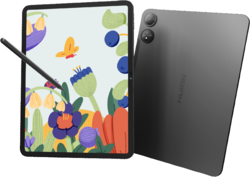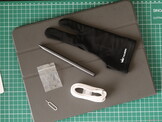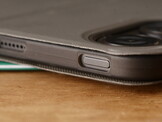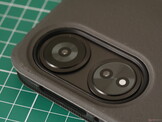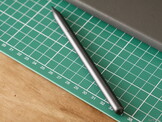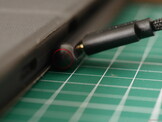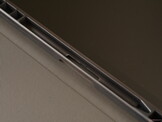
Affordable iPad alternative for artists marred by lacklustre stylus — Huion Kamvas Slate 13 hands-on test
If only it were $100 cheaper.
The Huion Kamvas Slate 13 is a 13-inch Android tablet that's ostensibly designed for artists, with its matte display, sketch-friendly aspect ratio, and included stylus with 4096 levels of pressure sensitivity, but in our review, the tablet exhibits a number of compromises and one fatal flaw. The Huion Kamvas Slate 13 might be an ideal note-taking tablet, but there are better digital sketch pads.Julian van der Merwe Published 🇫🇷 🇪🇸 ...
Verdict - A wobbly start for Huion's Android tablet line
The Huion Kamvas Slate 13 is trying to be an affordable alternative to Apple's iPad for digital artists, and it shows promise. However, while the on-paper specifications and features are impressive, the experience lacks polish. In its current state, the dim display, lacklustre pen experience, and the lack of software optimisation make it impossible to recommend over devices like the Samsung Galaxy Tab series and its S Pens. Even the original OnePlus Pad delivers a more satisfying drawing experience.
Of course, it's not all bad. The display, while antiquated and dim, has an excellent coating, and battery life is decent. MicroSD expansion and a 4:3 aspect ratio are also handy for digital art. If you're after something to serve as a main drawing device, the Huion Kamvas 13 is unfortunately difficult to recommend. If you can find it on sale for around $250–350, however, it may be a useful tool for those who just want to take notes, sketch ideas, or plan to use it on-the-go alongside a more serious drawing tablet.
Pros
Cons
Price and availability
The Huion Kamvas 13 is available on Amazon for $409 at the time of writing, and its smaller 11-inch sibling based on the same hardware, although with a faster 90 Hz display, costs $329 on Amazon. Usually, the Kamvas Slate 13 costs $449.99.
The Huion Kamvas Slate promises a "natural pen-on-paper experience" on a rather sizeable 12.7-inch display, on paper serving as a solid alternative to the likes of the Apple iPad. It is powered by a mid-range MediaTek SoC, 8 GB of RAM, and a 10,000 mAh battery. It runs stock Android 14 and features Huion's H-Pencil, a USI stylus with 4096 levels of pressure sensitivity and tilt recognition up to 60°.
Specifications
| SoC | MediaTek Helio G99 |
| RAM | 8 GB |
| Storage | 256 GB |
| Battery capacity | 10,000 mAh |
| Display size | 12.7-inch |
| Display resolution | 2176 × 1600 |
| Refresh rate | 60 Hz, IPS (25 ms claimed response time) |
| Pressure sensitivity | 4096 levels |
| Claimed brightness | 350 nits |
| OS | Android 14, no promise of Android updates |
| Included accessories | Drawing glove, USB C-to-C cable, pressure- and tilt-sensitive H-Pencil, folio case, microSD tray ejector tool, 3× extra pen nibs |
| Weight | 682 g |
Build quality and accessories
The Huion Kamvas 13, being a 13-inch tablet, is big, but it feels bigger than the 12.7-inch display size specification lets on — mainly due to the large bezels that are quite helpful in holding onto the tablet. The Android tablet doesn't feel unwieldy thanks to that weight, nor does it feel too thin or fragile. The tablet's case is made from what appears to be a solid piece of aluminium, which gives it a decently premium feel, although there is a plastic antenna section along one edge of the device.
The nano etched glass texture extends right up to the edge of the display panel, and it works well to both add a slight texture to the display and cut out reflections and glare, again conveying a rather premium look and feel, despite the relatively affordable pricing (when on sale, at least).
Except for the lack of an included charging brick, the Huion Kamvas Slate 13's accessory kit is decent. The ambidextrous drawing glove is stretchy enough that fits a range of hand sizes and reduces accidental touches.
Huion Kamvas Slate 13 as a digital art sketch pad and CAD ideation tool
I used the Huion Kamvas Slate 13 as a portable workstation for rudimentary digital art and sketching out ideas that would later become CAD models. The Kamvas Slate 13 should be great for this use case, thanks to its large display that has the perfect aspect ratio and texture for digital art. Unfortunately, it didn't quite work out to be the excellent art companion that its specifications promise — more on that later.
While the display is large, and the nano textured glass reduces glare and makes it easy on the eyes, it's not nearly bright enough for use outdoors. The drawing experience also suffers because of the 60 Hz refresh rate, which would normally be acceptable for a multimedia tablet, but becomes noticeably slow when using a direct input method like a stylus.
As an Android tablet, the Kamvas Slate 13 doesn't do much to stand out, either. The speakers are very quiet, and, while the battery life is good, charging is rather slow, taking around two hours for a full charge when the tablet is powered off. The 13 MP rear camera is passable for scanning documents and not much more, while the 8 MP front camera is likewise not worth writing home about. Both cameras are fine, but the money spent on the camera units would have been better spent on a better pen experience. Huion also uses the stock Android experience, which means it's low on bloat but also not very optimised for the large display.
During our testing in multiple drawing apps, the Kamvas Slate 13 didn't exhibit any performance issues, despite the mid-range Helio G99 SoC and 8 GB of RAM.
H-Pencil — disappointing line quality in an otherwise solid package
The biggest factor of any device intended for drawing or digital art is the stylus and line quality, and this is where things fall apart for the Huion Kamvas Slate 13. While the H-Pencil tracks accurately enough and has acceptable responsiveness, it also has enough wobble that it is almost unusable and definitely unusable without smoothing enabled. Palm and touch rejection could also be improved, as we noticed frequent accidental inputs while drawing with the H-Pencil, although this varies depending on the app, since some apps have built-in palm rejection.
In our testing, we've found that around 20% stroke smoothing works in apps like Sketchbook and Concepts to smooth out the wobbly lines. While this sort of smoothing is fine for quick sketches and ideation, it makes final inking, concept rendering, and illustration unnecessarily difficult. For a device ostensibly aimed at beginners who won't want to spend $500 or more on something like an iPad or Galaxy Tab S10 Plus or similar, the line quality of the H-Pencil adds too much complexity to the art process.
The wobble issue is made all the more unfortunate by the fact that the pressure and tilt recognition are both precise and easy to control. These features are held back in some apps, like concepts, where tilt cannot be adjusted mid-stroke, but the actual hardware implementation is great. The shortcut key on the stylus is also convenient in apps that can make use of it, although you do have to be careful to not accidentally trigger the key.
The only other minor niggle is that the H-Pencil needs to be charged via USB-C, although the battery lasts quite a long time. In our time reviewing the Slate 13, a single charge produced over a month of use with the pen, even with a decent amount of sketching.
Following is a short video demonstrating the line wobble of the Huion Kamvas Slate 13 and its H-Pencil. The clip has not been slowed down or sped up.
Conclusion
If it weren't for a subpar stylus experience, the Huion Kamvas Slate 13 would be an excellent iPad replacement for beginner artists. However, as it stands, we cannot recommend the Slate 13 as anything more than a basic ideation and sketching tool. Perhaps if you're looking for a big, fairly lightweight tablet with a 4:3 aspect ratio to jot down ideas on the go, it is worth considering, but the lacklustre pen experience makes ir difficult to recommend as a main drawing tool.
Transparency
The selection of devices to be reviewed is made by our editorial team. The test sample was given to the author by the manufacturer free of charge for the purposes of review. There was no third-party influence on this review, nor did the manufacturer receive a copy of this review before publication. There was no obligation to publish this review. As an independent media company, Notebookcheck is not subjected to the authority of manufacturers, retailers or publishers.




